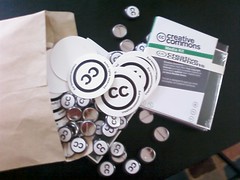
On 11 November 2011 I had the pleasure to participate as a speaker at the conference “Sharing is Caring: Digitised Cultural Heritage for All” arranged by the Association of Danish Museums. I gave a presentation on Creative Commons and how open licensing of content could be successfully applied within GLAM. GLAM is the Creative Commons abbreviation for galleries, libraries, archives and museums.
I came away from the conference being very optimistic about the future of open access to our cultural heritage to the Danish GLAM organisations.
My optimism came about not only because the conference was held in a very Creative Commons-friendly atmosphere with a lot of knowledgeable presentations by great people from Danish and foreign cultural institutions, but also because the debate among the participants really convinced me that the mindsets of those people who are running the business of the Danish GLAMs are very much in favour of making their content and data available to the largest degree possible under open licences.
Almost everybody present at the conference gave the clear impression of being “clued in” to openness (maybe with the exception of a few lonely participants representing the usual suspects among the organisations of the rightholders).
(It also struck me that a lot of the people giving presentations were extremely talented in the sense that they could easily land maybe much more profitable jobs in the private sector, if it was not for their passion and enthusiasm to work with our cultural heritage).
There seems to be a general consensus that the point of departure for GLAMs should be that the content and data that these had the rights to license freely should be made accessible for the public on open licensing. Even though that many of the participants in the conference were not that familiar with Creative Commons, it seems to me that it would be possible in the future to actually make Creative Commons licensing of content and data for these GLAMs the default choice.
Not only is it obvious that making GLAM content and data available under a Creative Commons licence would serve to fulfil a public policy goal of making our cultural heritage as freely available for as many people both in Denmark and abroad as possible. But Creative Commons licences will also make sense for these institutions from a purely commercial or business point of view.
There are many different business models that could be applied when using Creative Commons licences for GLAM content and data. A Creative Commons licence for a collection of photos would enable this content to be fully shared and distributed in a manner that could substantially increase knowledge and awareness about the particular institution thereby saving a large amount of money that would otherwise have to be spent on branding the institution. Such increased marketing effects would obviously, besides the more general positive effects, mean increased ticket sales.
Releasing content under a specific taylored Creative Commons licence, for instance the CC licence that allows for non-commercial use but requires a special licence for commercial use, would also serve as a sales-lead generating tool for creating increased revenue with respect to commercial licences for, for instance, the same photos for the institutions mentioned above.
Hopefully the Danish Association for Museums will continue their work to discuss open licensing models within Danish GLAMs, not just with another conference here, but also maybe with workshops and other initiatives in the meantime. I am sure that we at Creative Commons Denmark will do what we can to support this effort.

Leave a Reply